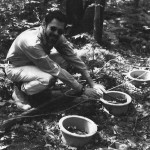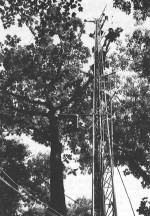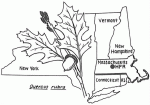During the 150-year period starting in 1750, the landscape of central New England underwent a complete transformation. Settlers cleared forests at a prolific rate, established pasture and cropland across 50 to 75 percent of the upland area to support a mixed agricultural economy of grain, beef and dairy production and, subsequently, abandoned this open land to pursue urban jobs and agricultural opportunities in the Midwest.
Today, forest vegetation covers 65 to 95 percent of the region and broad-scale human activities continue to exert a pronounced impact. Logging operations maintain a largely even-aged structure to the forests on public and private lands, and introduced pathogens have severely impacted populations of chestnut, elm, beech and, most recently, hemlock. Air masses crossing major urban and industrial centers in the Midwest and Atlantic states impose chronic inputs of nitrogen, sulfur and other byproducts of fossil fuel production and subject the area to episodes of high ozone concentrations.
Clearly any comprehensive understanding of forest ecosystems in this region must include an assessment of the impacts and legacies of these human activities. Meanwhile, natural processes have been far from static.
Historical reconstructions and paleoecological studies indicate that wind damage, ranging from small gaps to infrequent broad-scale blowdown resulting from hurricanes, is probably the most important natural disturbance. Recent studies suggest that fire may have occurred at intervals of a few hundred to a thousand years.
Past Research Efforts
In recognition of the dynamic nature of these forests the HFR LTER program has focused its efforts on an understanding of the forest ecosystems in central New England within a context of historical and modem factors initiating change. To do this, we have assembled a group representing Harvard University, the University of New Hampshire, the Ecosystem Center at Woods Hole, plus five additional institutions.
Major efforts continuing from the onset of the program include: analysis of biosphere/atmosphere interactions (fluxes of carbon and nitrogen gases, ozone, heat and water vapor) on a 30-rn environmental monitoring station, assessment of the nitrogen saturation hypothesis in conifer and hardwood forests, historical and paleoecological analysis of forest and environmental change, and integrated studies of ecosystem recovery after simulated hurricane and pathogenic attack to forests. In the hurricane simulation study we have pulled over two areas (0.5 and 0.8 ha) of hardwood forest, whereas to study the impact of pathogens we are selectively killing one overstory species in 0.2-ha plots. In 1991 the following new projects were initiated by HFR LTER scientists with support from additional funding sources.
GIS Analysis of Land-Use & Forest Change Across Central New England
This historical project is assessing spatial variation in the type and intensity of land-use activity across the cultural and environmental gradients that exist in New England from the Connecticut River Valley to the surrounding Highlands. This history is being related to past and modem variation in the extent and type of forest vegetation. The project is partially funded by NSF programs in Ecology and Human Dimensions of Global Change and the Mellon Foundation.
Modeling the Meteorology of Historical Hurricanes in New England
To better understand spatial variation in hurricane impacts to the New England landscape, a meteorological model developed as part of the Luquillo LTER site analysis of Hurricane Hugo in Puerto Rico is being utilized. The project seeks to reconstruct the meteorological scenarios for important past storms (1600 A.D. to the present), to develop a more comprehensive understanding of the disturbance regime in New England, and to interact this model with landscape features and vegetation on GIS.
Soil Warming Experiment
The response of the below-ground system to global warming is being assessed in a soil-warming experiment in a mixed hardwood forest conducted in collaboration with the Ecosystem Center at Woods Hole. Treatments consist of six 5 x 5-m replicates of
- Experimental plot with the soil temperature 5°C above ambient
- Control plot
- "Disturbed” control with heating wires installed but not turned on
Soil and ecosystem processes examined include mineralization, decomposition, soil trace gas fluxes and leaching losses. The project is partially funded by the U.S. Environmental Protection Agency and Department of Energy (DOE).
Ecophysiology of Canopy Trees/ Scaling from Leaf to Ecosystem Level
In a project seeking to link the ecosystem measurements made in the Environmental Monitoring Station (EMS) with physiological studies of individual leaves, HFR researchers have erected two canopy-access towers from which detailed micrometeorological and physiological measurements can be made. From each tower there is access to at least one individual of four species of tree (red maple, white pine, red oak, and paper birch). Physiological response is being correlated with micrometeorological measurements (PAR, humidity, wind speed, temperature) and concentrations of trace gases and pollutants measured at the EMS. Funding is provided by DOE and the NSF Ecosystem program.
Expansion of the Atmosphere/Biosphere Monitoring Program
The presence of the Environmental Monitoring Station and electrical and telephone service in the center of the Prospect Hill tract at the Harvard Forest have served to attract much of the field research associated with the DOE-funded Northeast Institute for Global Environmental Change to the site. New experiments include assessments of turbulence and turbulent exchange, and of atmospheric methane, nitric acid, and atmospheric SO.
These new research efforts continue to attract additional researchers to the Harvard Forest. This past summer, more than 40 scientists from outside groups worked with the HFR LTER science team, and 20 undergraduate students were supported in our Summer Research Program.
For further information contact David Foster, Harvard University, Harvard Forest, Petersham, MA 01366, 508-724-3302.

 Enlarge this image
Enlarge this image


